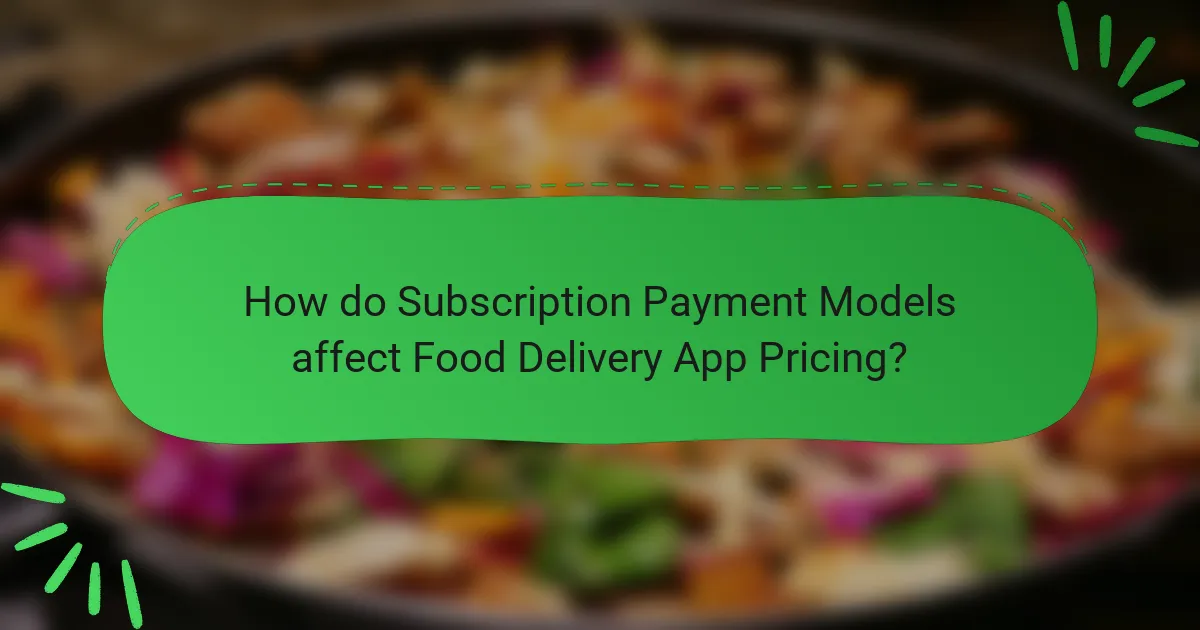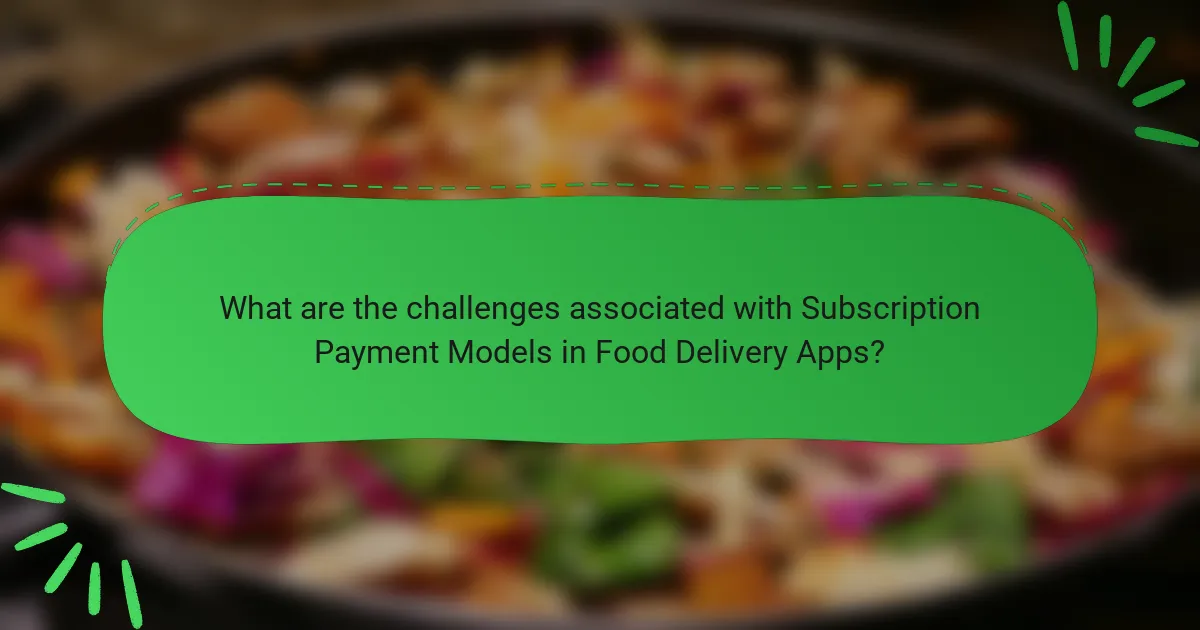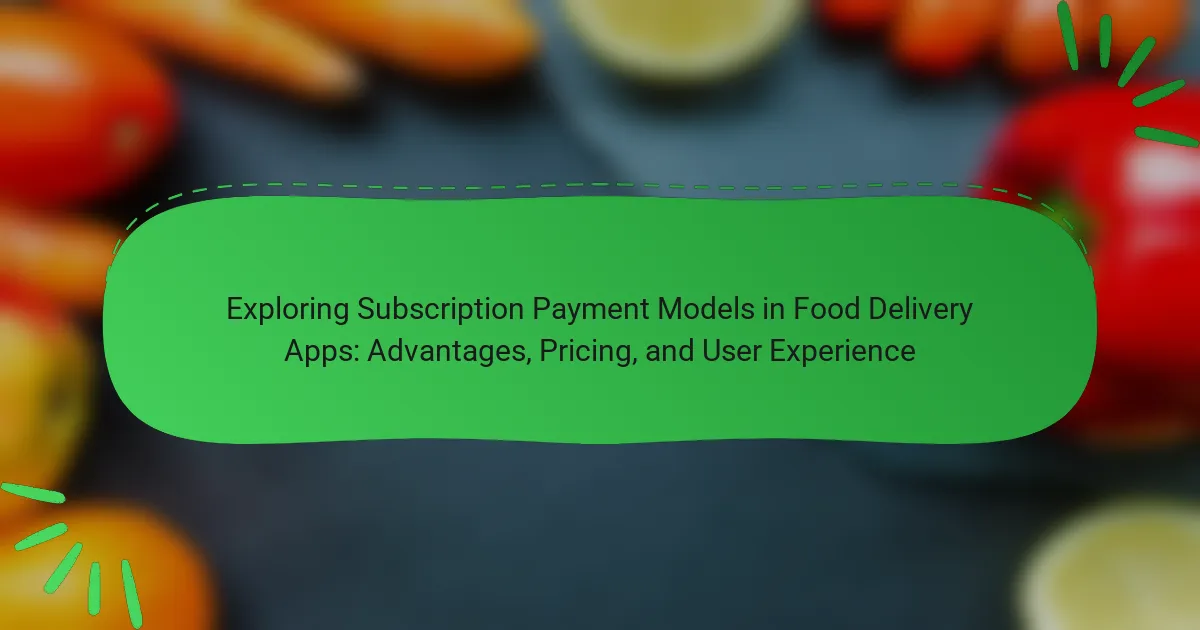Subscription payment models are pricing structures used by food delivery apps, allowing users to pay a recurring fee for services that often include benefits like free delivery and discounts. These models encourage customer loyalty and increase retention rates, with studies indicating significant boosts in average order frequency and customer lifetime value. While they provide cost-effective options for users and stabilize revenue for food delivery companies, challenges such as customer retention, pricing strategy, and competition must be managed effectively. The article explores the advantages of subscription models, their impact on pricing, and the importance of user experience in maintaining successful subscriptions.

What are Subscription Payment Models in Food Delivery Apps?
Subscription payment models in food delivery apps are pricing structures that allow users to pay a recurring fee for services. These models often provide benefits such as free delivery, discounts, or exclusive access to promotions. Users typically subscribe on a monthly or annual basis. This approach encourages customer loyalty and consistent usage. Research indicates that subscription models can increase average order frequency and customer retention rates. For example, a study by McKinsey found that food delivery subscriptions can lead to a 20-30% increase in customer lifetime value.
How do Subscription Payment Models differ from Traditional Payment Methods?
Subscription payment models provide ongoing access to services for a recurring fee. In contrast, traditional payment methods involve one-time transactions for goods or services. Subscription models often offer lower upfront costs, allowing users to spread payments over time. This can enhance user loyalty and engagement, as customers are more likely to continue using the service. Traditional payments typically require full payment at the time of purchase, which can deter some consumers. Subscription services may include additional benefits, such as discounts or exclusive content, which are not available in traditional models. For example, food delivery apps often provide subscribers with free delivery or reduced service fees. This incentivizes users to choose subscription options over traditional payments.
What are the key characteristics of Subscription Payment Models?
Subscription payment models are characterized by recurring billing for services or products. They typically involve a fixed fee charged at regular intervals, such as monthly or annually. These models provide users with continuous access to offerings without the need for individual transactions. Subscription models often enhance customer loyalty through consistent engagement. They can include various tiers, offering different levels of service at varying price points. Flexibility is a common feature, allowing users to modify or cancel subscriptions easily. Data suggests that subscription services can increase customer lifetime value by fostering long-term relationships. Overall, these models streamline the purchasing process and can lead to predictable revenue for businesses.
How do these models impact consumer behavior?
Subscription payment models significantly influence consumer behavior in food delivery apps. These models encourage frequent usage by offering convenience and perceived value. Consumers are more likely to order regularly when they have a subscription that reduces individual meal costs. Research shows that subscription services can increase customer retention by up to 30%. This is due to the commitment consumers feel towards their subscription. Additionally, subscription models often provide exclusive offers and enhanced features, further driving engagement. The predictable cost structure also aids in budgeting for consumers, making them more inclined to use the service consistently.
What are the advantages of Subscription Payment Models for Users?
Subscription payment models offer users predictable costs and convenience. Users can enjoy a fixed monthly fee that simplifies budgeting. This model often provides access to exclusive deals and discounts. Users benefit from reduced prices compared to pay-per-use options. Subscription services frequently include free delivery or faster service. This enhances the overall user experience. Research indicates that users prefer subscription models for their flexibility and value. A study by McKinsey found that 15% of consumers have subscribed to at least one service, highlighting its popularity.
How do Subscription Payment Models enhance user convenience?
Subscription payment models enhance user convenience by providing a seamless and automated billing process. Users benefit from predictable costs, making budgeting easier. These models often eliminate the need for repeated transactions, saving time during checkout. Subscriptions can also offer exclusive access to features or discounts, adding value for users. Many food delivery apps allow users to customize their subscriptions based on preferences. This personalization enhances the user experience by catering to individual needs. Additionally, subscriptions often include free delivery or reduced fees, further incentivizing usage. Overall, subscription payment models streamline the purchasing process and improve user satisfaction.
What cost savings can users expect from these models?
Users can expect significant cost savings from subscription payment models in food delivery apps. These models often provide discounts on delivery fees, which can reduce overall expenses. For example, some subscriptions offer free delivery for a monthly fee, saving users up to $10 per order. Additionally, users may receive exclusive deals or discounts on menu items, further lowering costs. Research indicates that users can save an average of 20% to 30% monthly compared to pay-per-order models. This savings can accumulate, especially for frequent users.

How do Subscription Payment Models affect Food Delivery App Pricing?
Subscription payment models significantly influence food delivery app pricing by providing users with cost-effective options. These models often include monthly or annual fees that allow subscribers to access discounted delivery rates or waived delivery fees. For example, a study by Deloitte found that 68% of consumers prefer subscription services for their perceived savings. This pricing strategy encourages customer loyalty and increases user retention.
Additionally, subscription models can stabilize revenue for food delivery companies, allowing them to invest in better services. According to a report by Statista, the global food delivery market is projected to reach $150 billion by 2023, partly driven by subscription services. These models also create predictable cash flow, enabling apps to offer competitive pricing. Overall, subscription payment models reshape food delivery app pricing by enhancing value for users while ensuring steady income for providers.
What pricing strategies do food delivery apps use for subscriptions?
Food delivery apps use various pricing strategies for subscriptions, including tiered pricing, flat-rate pricing, and promotional pricing. Tiered pricing allows users to choose different subscription levels based on their usage needs. For example, a basic plan may offer limited deliveries, while a premium plan includes unlimited access. Flat-rate pricing charges a fixed monthly fee for all deliveries, simplifying budgeting for users. Promotional pricing often includes discounts for the first few months to attract new subscribers. According to a report by Statista, the subscription model has seen significant growth, with many users preferring the predictability of monthly costs. These strategies help food delivery apps enhance user retention and increase overall revenue.
How do these strategies compare to pay-per-order pricing?
Subscription payment models in food delivery apps differ significantly from pay-per-order pricing. Subscription models require users to pay a recurring fee for access to services or discounts. In contrast, pay-per-order pricing charges users for each individual transaction. Subscriptions can lead to cost savings for frequent users, while pay-per-order is more flexible for occasional users. Research indicates that subscription models can increase user retention by 20% compared to pay-per-order systems. Additionally, subscriptions often include benefits such as free delivery or exclusive offers, which are not available in pay-per-order pricing. This creates a more predictable revenue stream for companies, enhancing financial stability.
What factors influence subscription pricing in food delivery apps?
Subscription pricing in food delivery apps is influenced by several key factors. These factors include market competition, consumer demand, and service offerings. Market competition determines how pricing strategies are developed to attract users. High competition often leads to lower prices or added benefits to retain customers. Consumer demand affects how much users are willing to pay for convenience and additional features. The variety of service offerings, such as delivery speed and exclusive deals, also impacts pricing. Additionally, operational costs, including delivery logistics and partnerships with restaurants, play a significant role in shaping subscription prices.
How do Subscription Payment Models impact the overall user experience?
Subscription payment models enhance the overall user experience by providing convenience and cost savings. Users benefit from predictable billing cycles, which simplify budgeting. These models often include perks such as discounts or exclusive access to features. For instance, a study by Deloitte found that 77% of consumers prefer subscription services for their ease of use. Additionally, subscription models can reduce decision fatigue by offering curated options. This streamlines the ordering process, making it quicker for users. Furthermore, loyalty programs tied to subscriptions can increase user satisfaction and retention. Overall, subscription payment models create a more engaging and user-friendly experience in food delivery apps.
What role does user feedback play in shaping subscription features?
User feedback plays a crucial role in shaping subscription features. It helps developers understand user preferences and pain points. Feedback can reveal which features users value most. This allows for prioritization of feature development. For instance, a survey may show that users prefer flexible payment options. As a result, developers can implement these options to enhance user satisfaction. Additionally, user feedback can guide improvements in user interface design. This leads to a more streamlined experience for subscribers. Ultimately, incorporating user feedback fosters a more responsive and user-centered subscription model.
How do subscription models affect customer retention and loyalty?
Subscription models significantly enhance customer retention and loyalty. These models create a consistent revenue stream and foster ongoing engagement. Customers are more likely to remain loyal when they perceive value in their subscriptions. For example, a study by McKinsey found that subscription services can lead to a 30% increase in customer lifetime value. Additionally, subscription models often include personalized experiences, which strengthen customer relationships. This personalization makes customers feel valued and understood. Consequently, loyal customers are more likely to refer others, further boosting retention rates. Overall, subscription models effectively build a loyal customer base through perceived value and personalized experiences.

What are the challenges associated with Subscription Payment Models in Food Delivery Apps?
Subscription payment models in food delivery apps face several challenges. One major challenge is customer retention. Users may cancel subscriptions if they perceive limited value or variety in offerings. Another challenge is pricing strategy. Setting a price that attracts users while ensuring profitability is complex. Additionally, competition from other delivery services can lead to price wars, impacting margins. User experience is also critical. Poor app performance or delivery issues can deter subscribers. Lastly, managing subscription logistics, such as meal customization and delivery frequency, can complicate operations for providers. These challenges require careful management to maintain a successful subscription model.
What common issues do users face with subscription services?
Users face several common issues with subscription services. One major issue is unexpected charges. Users often experience billing errors or unauthorized charges. Another problem is cancellation difficulties. Many users find it hard to cancel subscriptions due to complex processes. Additionally, users frequently encounter limited content access. Some services restrict features based on subscription tiers. Poor customer support is also a prevalent issue. Users report long wait times and unhelpful responses from service representatives. Finally, lack of transparency is a concern. Users may not fully understand the terms and conditions of their subscriptions. These issues can lead to dissatisfaction and frustration among users.
How can food delivery apps address these challenges?
Food delivery apps can address challenges by implementing subscription payment models. These models provide users with predictable pricing and reduce transaction fees. Subscriptions can offer benefits like free delivery or discounts on orders. This encourages customer loyalty and increases order frequency. Research indicates that subscription services can enhance user experience by simplifying payment processes. A study by McKinsey found that subscription services can lead to a 15-20% increase in customer retention. By addressing pricing transparency and convenience, food delivery apps can effectively meet user demands.
What best practices can enhance the effectiveness of Subscription Payment Models?
Implementing user-friendly interfaces enhances subscription payment models. Clear navigation improves customer experience. Offering flexible payment options increases user satisfaction. Providing transparent pricing builds trust with subscribers. Regularly updating content keeps users engaged and reduces churn. Personalizing offers based on user behavior can boost retention rates. Analyzing user feedback helps identify areas for improvement. These practices lead to higher conversion rates and increased revenue.
How can food delivery apps optimize their subscription offerings?
Food delivery apps can optimize their subscription offerings by personalizing plans based on user preferences. Tailoring options enhances user satisfaction and retention. Analyzing customer data helps identify popular menu items and delivery times. Implementing flexible pricing models can attract a wider audience. Offering tiered subscription levels can cater to different spending habits. Regularly updating subscription benefits keeps the offerings fresh and appealing. Promotions and discounts for long-term subscribers can incentivize commitment. Customer feedback should guide ongoing adjustments to improve the subscription experience.
What strategies can improve user engagement with subscription services?
Personalization enhances user engagement with subscription services. Tailored content and recommendations increase relevance for users. Data shows that personalized experiences can boost engagement by up to 80%. Regular communication through emails or notifications keeps users informed and engaged. Offering exclusive content or discounts incentivizes users to remain active. Utilizing gamification techniques can also increase interaction and retention. A study from McKinsey found that gamified experiences improve user engagement by 30%. Lastly, soliciting user feedback fosters a sense of community and involvement, leading to higher satisfaction and loyalty.
Subscription payment models in food delivery apps are structured pricing systems that allow users to pay a recurring fee for services, offering benefits like free delivery and discounts. This article explores the differences between subscription models and traditional payment methods, highlighting their key characteristics and impact on consumer behavior. It also examines the advantages for users, such as cost savings and enhanced convenience, while discussing pricing strategies and challenges faced by providers. Additionally, the article addresses best practices for optimizing subscription offerings and improving user engagement, ultimately demonstrating how these models can enhance customer retention and loyalty.
